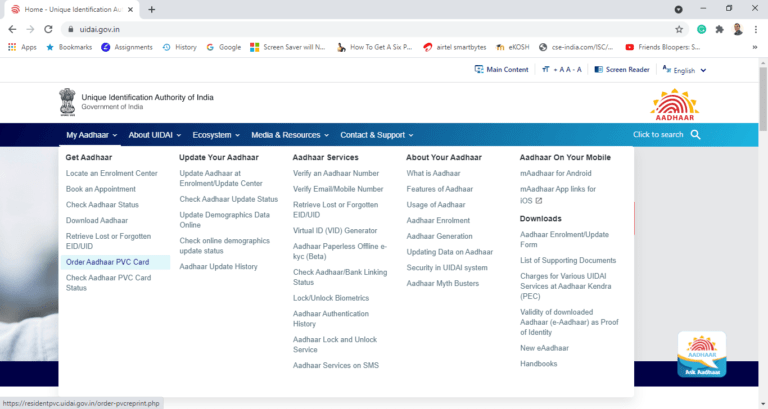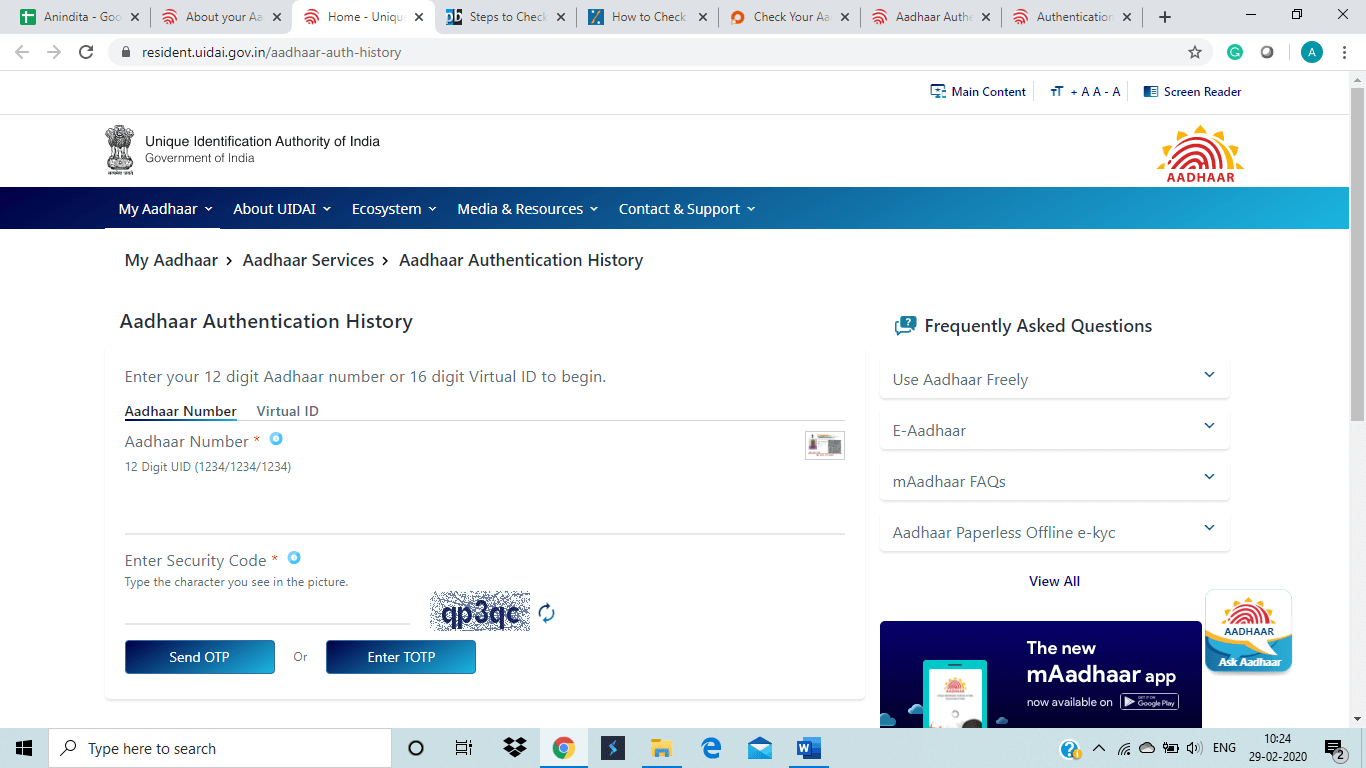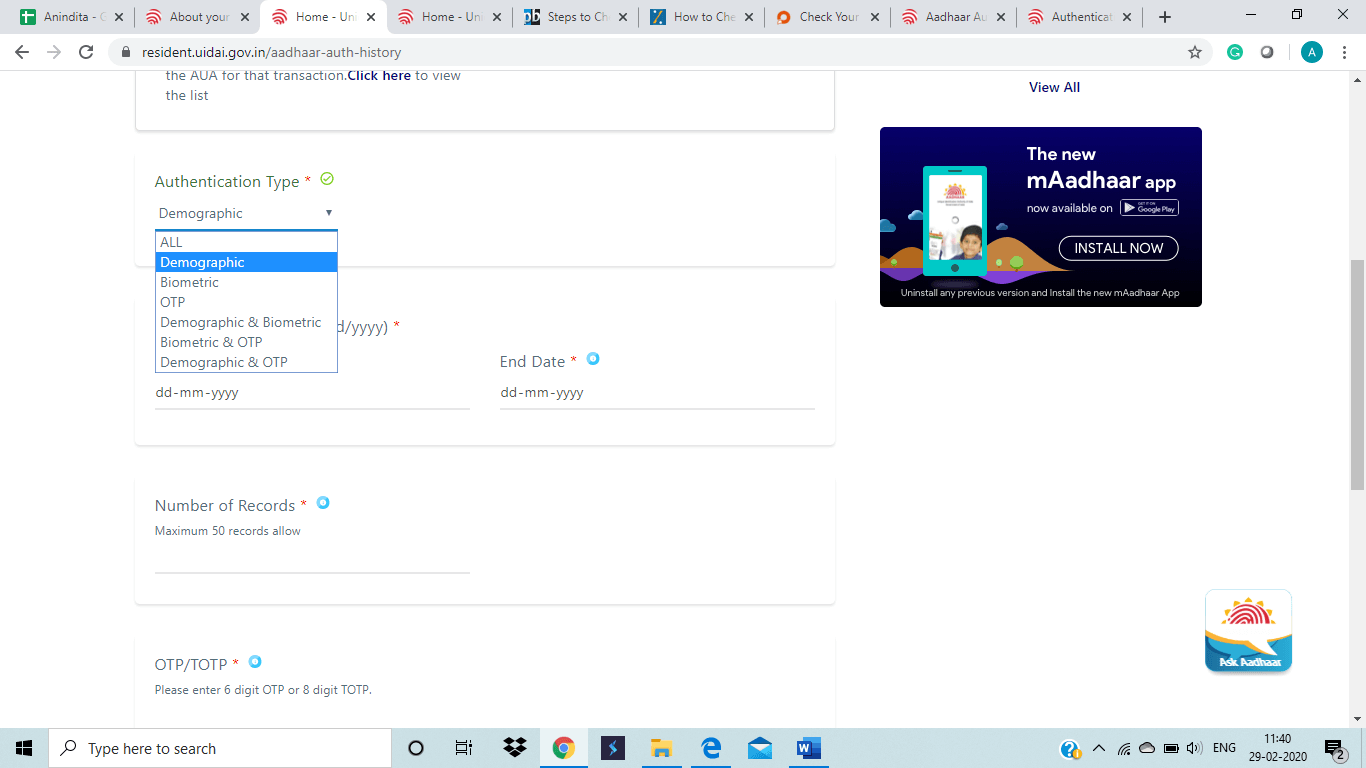Aadhaar is a 12-digit unique random number that is issued by the UIDAI- Unique Identification Authority of India to the Indian residents after a set of the identification process arranged by the Authority. Any person, regardless of gender and age, and is a resident of the country, may willingly enrol to get Aadhaar number. The Individual has to provide minimum demographic and biometric information at the time of the enrolment procedure which is completely free of charge. The person needs to enrol for Aadhaar only on one occasion after which only one Aadhaar will be created, as the exclusivity is attained through the method of capturing their demographic and biometric data.
Aadhaar number is confirmable online and it is cost-effective. Its uniqueness is sufficient to eradicate duplicates and false identities and can be used as a key identifier to roll out numerous Government welfare arrangements for better service distribution thus endorsing transparency and strong governance. Internationally this is the first step of its kind, in which a digital and online Id is provided free at a mass scale to Indian residents.
Aadhaar identity platform comes with its intrinsic features of distinctiveness, authentication, financial information and e-KYC. Here we will talk more about the authentication aspect and understand what it is all about.
What is Aadhaar Authentication?
Aadhaar Authentication is a process by which the Aadhaar number together with the demographic and biometric statistics of an Aadhaar cardholder is deposited into the Central Identities Data Repository or CIDR for its authentication and such storehouse validates the accuracy of the data or whether the same is insufficient basis the available data on it.
Many service providers require people to submit their proof of identity that will enable them to provide various customer services, grants or benefits. While gathering such ID proofs, the service providers come across many issues in terms of substantiating or authenticating the exactness of the identity documents or the evidence submitted by people.
Aadhaar Authentication aims to provide an online platform of identity to validate the identity of the Aadhaar card holder promptly anytime and at anyplace.
UIDAI provides Aadhaar-based authentication as a facility that the requesting establishments can take the benefit of. They can be any government organization or a public limited company or maybe a private entity or agency. This particular service provided by UIDAI can be used to authenticate the identity of their employees or customers or any other acquaintances basis the match of their individual identity information, before giving them access to their customer services or rebates or the benefits, etc.
Steps to check Aadhaar authentication online
From the above discussion, it is clear that completing the Aadhaar authenticationis extremely crucial. In simple language, it means that you must verify or authenticate your details that you have provided in the Aadhaar Card. Let us now need the steps that need to be followed for doing Aadhaar authentication.
Step1: Visit the UIDAI official site https://uidai.gov.in/ and under “My Aadhaar” you will be able to see another sub-section “ Aadhaar Services” from where you can go to “ Aadhaar Authentication History” as shown in the below figure

Step 2: You need to enter your 12-digit Aadhaar number or UID or 16-digit Virtual Identification Number or VID as shown below

Step 3: Enter the security code in the relevant space provided. In case you are not able to read or see the code, you can click on ‘Try Another’ to get a fresh security code
Step 4: Click on “Send OTP” and the OTP will be sent to your registered cell number
Step 5: You will be able to see one more page on the UIDAI website
Step 6: Choose the ‘Authentication Type’ from Demographic or Biometric or OTP or Biometric and OTP or Demographic and Biometric or Demographic and OTP or All as shown below

Step 7: Select the date range “From” and “To” for which you want the authentication to be done
Step 8: You need to enter the number of records which is limited to 50 and click on OTP
Step 9: Enter the OTP and then click on submit
Step 10: After completing the above steps, you will see the Aadhaar authentication history on the page
What is Aadhaar authenticationhistory
Aadhaar Authentication history shows the details of authentication completed by your resident in the past.
Whenever you use Aadhaar to avail of any service, UIDAI record the transaction. Demographic or Biometric data is not stored in Aadhaar’s database. Very few details of some transaction are saved like below:
- Category of the transaction whether its demographic or biometric or OTP-based
- Date as well as the time of the transaction
- Organization for Authentication like UIDAI, EPFO, etc.
- Response code for UIDAI
- Unique Aadhaar Transaction ID
- Response for Authentication meaning the transaction is a success or failure
- Error code of UIDAI, if applicable
Point to note here is that there are only 50 results for the past 6 months which can be raised when you are checking the Aadhaar authentication history. This implies you will be able to view a maximum of 50 records at a time. UIDAI permits you to check transactions of six of types of authentication and they are mentioned as follows:
- Biometric
- Demographic
- OTP
- Biometric and OTP
- Demographic and OTP
- Demographic and Biometric
You have the liberty to choose a precise date range for seeing your Aadhaar authentication history. But this range must not be more than a period of six months. In case you would like to search for a particular transaction, you need to select the exact type of authentication and the applicable date range.
Benefits of Aadhaar authentication
The process of Aadhaar authentication has many benefits in comparison to using the offline techniques and they can be listed as below:
- Since Aadhaar card is an official and legal document to prove your identity, you can furnish the same for many kinds of requests service applications like opening of a bank account in both public and private sector, while applying for passports, for child’s admission in any school, applying for a new LPG connection with rebates or may without any rebates
- Any service provider can effortlessly identify any beneficiaries as and when needed which in turn help them to know whether the beneficiary is entitled to avail the specific service or can get the related benefit
- Aadhaar authentication supports in authenticating the monetary transactions which are done through the Unified Payment Interface or better known as UPI -a mobile-based application
- The newly launched mobile application BHIM- Developed by the National Payments Corporation of India, created on the Unified Payments Interface also use Aadhaar to support all the transactions which are done between the merchants and its consumers
Modes of Aadhaar authentication
Aadhaar authentication request will be encouraged by UIDAI only when the request is sent by a requesting entity by electronic means and are as per the guidelines and in compliance with the stipulations laid down by UIDAI. The requesting service provider can select a suitable mode or modes of authentication for a specific service or function as per the necessity, together with combined factor of authentication as explained below for enhanced safety and security.
Aadhaar authentication can be done through the following modes:
- Demographic authentication: Your Aadhaar card number and demographic data needs to match with your demographic information in the CIDR- Central Identities Data Repository
- Authentication based on OTP or One Time Pin: An OTP, having restricted time validity, will be sent to your registered cell number and or e-mail address. You need to provide this OTP together with your Aadhaar number at the time of authentication and the same will be matched with the OTP which is being generated by UIDAI
- Authentication based on Biometrics data: Your Aadhaar card number and biometrics data needs to match with your biometric statistics in the CIDR- Central Identities Data Repository. This can be your fingerprint or iris-based validation or further biometric modalities
- Combined authentication: For Aadhaar authentication a grouping of two or more of the above-mentioned modes can be used for authentication.
Why is Aadhaar authentication essential?
There are several public and private organizations that provide rebates, benefits, and varied services to its customers, employees, and others as explained above These agencies need a validation procedure that is simple, easy, prompt, and most importantly dependable to perform their functions. The presence of numerous kinds of identification papers makes it problematic and hard for these agencies to authenticate every kind of document with full accuracy. When a person is needed to furnish any identity proof for any official or legal applications, they usually submit many kinds of proof of identity starting from a driving license, PAN card, passport, etc. and therefore becomes a very difficult task to validate the same. With the new concept of Aadhaar Authentication, the Unique Identification Authority of India or UIDAI is expectant to have a more consistent and dependent technique of identifying documents that are submitted by the individuals. The data gathered after the biometric authentication and demographic verification of a person is kept in a UIDAI centralized database.
Also, more importantly, Aadhaar Authentication will help to eliminate duplication of documents and will be able to provide precise and exact data which will help to implement various direct benefit programs as explained above. The biometric and demographic information that an Aadhaar card has gives a high condition to uphold the security of the entire Aadhaar Authentication procedure.
Aadhaar is a strategic plan designed for an overall improvement in the social and financial matter and to promote a hassle-free means of providing the online facility. The Aadhaar platform is one of the significant pillars of ‘Digital India’, where all resident Indians can avail the same and obtain a unique identity. Aadhaar has already accomplished many milestones and as of now is the biggest biometric-based proof of identity scheme in the world.
FAQ’s
For all failed authentication transaction records, a definite error code is allotted. Check the details of the shown error code number against the failed transaction to identify the exact reason for such failure.
You need to contact the respective Authentication User Agency or AUA for further inquiry if the recorded authentication transaction is not performed.
For all authentication transactions done by you, Authentication User Agency -AUA creates a unique Transaction ID to recognize the transaction and send it to UIDAI as part of the authentication. This Transaction ID together with the Response Code can be used by you for any further investigation from AUA.
UIDAI provides authentication facilities with various modes like demographic, biometric or a One Time Password or OTP. Auth Modality tells us the manner of authentication that has been used to perform that definite authentication transaction.
You can get the following information in Aadhaar Authentication history against every Authentication done by you.
- Auth Modality
- Response code of UIDAI
- Authentication Date and Time
- Name of AUA
- AUA Transaction ID with the code
- Authentication Response being a success or a failed transaction
- Error code of UIDAI


